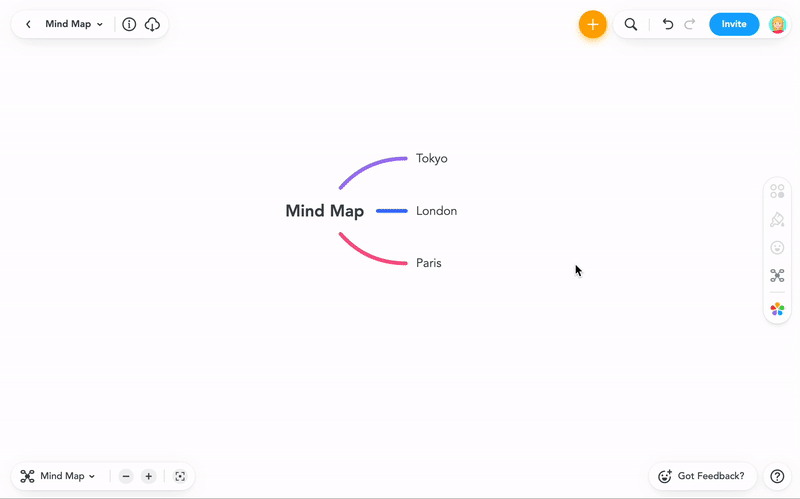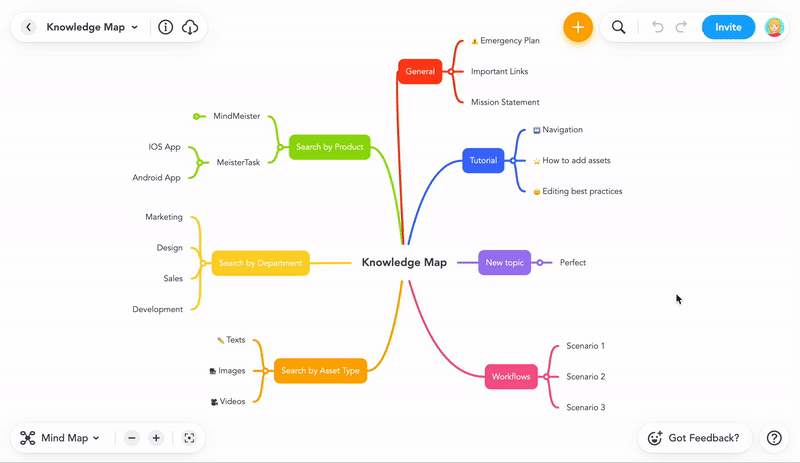Everyone remembers a good story, but a story by itself will only go so far. That’s why storytellers are increasingly using video content to get their point across, and effective planning with mind maps to help them create the best visual content around. Mind mapping enables you to centralize your ideas, invite others to collaborate with you, and manage your project seamlessly from ideation to execution. Here’s how you can use MindMeister, an online collaborative mind mapping tool, to plan your next video to perfection.

A good storyteller needs the right vehicle to hook in their audience, keep them engaged, and leave them with a lasting impression. Video is the perfect medium – creating experiences that are memorable, moving and inspiring in a world where our attention spans have shortened. It has been said that storytelling is queen, but video content is king when it comes to impact and message retention: viewers retain a whopping 95% of a message watched in a video.
Creating a video can be a complex process. But it’s not as daunting as you might think. If you’re struggling to organize your thoughts and ideas and bring them together in a visually cohesive way, there’s an effective technique you can use to get the ball rolling. It’s called mind mapping.
What Is Mind Mapping?
Mind maps are visual representations of information. Unlike the traditional, linear notes you might make in a text document or using pen and paper, mind maps allow you to capture your thoughts and ideas on a blank canvas. You always start with the main idea in the center of the map and related ideas branch off from the center in all directions, creating a radiant structure. The big advantage of mind maps is that they foster creativity, while also providing a flexible format for project planning. Mind maps can store and structure vast amounts of information. They display hierarchy, show relationships between individual ideas and enable you to see the “big picture” at a glance. These are features which make mind maps the ideal content planning tool.
Mind maps – sometimes referred to as content maps by content creators – help creatives, marketers, and even teachers who make video lessons to tap into their creativity and put out great videos. Let’s take a closer look at what content mind mapping is, and how you can use this technique to plan your own videos using our step-by-step guide.
Why Should I Mind Map Content Ideas?
Mind mapping works well in a lot of areas – goal setting, information management, ideation and, of course, video planning. Mind maps help to boost creativity, keep you focused, and improve your productivity.
Mapping your video content is especially useful because it allows you to both visualize a process and store away ideas for future video projects. When you brainstorm with mind maps, all of your ideas are equally valid – even if they’re not right for the particular project you’re working on now, they could be relevant for future projects. You can use the duplication feature in MindMeister to copy useful mind maps and create templates that can be reused again and again – meaning you don’t have to start from scratch each time.
Read more about essential MindMeister features such as templates and themes.
MindMeister for Online Mind Mapping
MindMeister is the quintessential mind mapping tool, and it’s perfect for mind mapping your video lessons too! From a blank mind map or a template, you can add your main idea and create topics around it, then use its free topic positioning feature to move ideas around. The great thing about MindMeister is that it lets you add multimedia to your map too, which means that you can even use it to create a knowledge map of all the videos you’ve made.
While mapping, MindMeister’s version history feature helps you to see previous changes as you’ve saved them. This allows you to find and edit previous ideas or edit ideas that someone else added.
MindMeister is built for distraction-free ideation. To help you stay focused and on message, you can always use MindMeister’s focus mode to hide menus, toolbars or icons, allowing you to focus on what matters most – your ideas.
How To Use Mind Mapping To Plan Video Lessons
Now you’ve chosen the perfect online mind mapping software, the process of planning your video lesson becomes much easier. To illustrate the concept of mind mapping, as well as some of the MindMeister features that can help you get the most out of it, we’ll go through the process to show you how you might create an educational video.
Step 1: Use Mind Maps to Brainstorm Ideas
Start With a Central Idea
The first step in creating your educational video will involve you brainstorming your ideas. In the world of education, concepts can be complex and lead to a whole series of videos on the same topic. For example, a science teacher might want to create a video series on the various scientific kingdoms for classification, or a math teacher could produce a series on the core elements of mathematics. The central ideas here are Biology Kingdoms and Math Core Elements.
Branch Out From the Central Idea
At this stage we’re still brainstorming ideas, not yet generating any actual content – we’ll get to that. So focus on the 5 Ws – who, what, when, where, why – to understand your content and who it’s for.
Place your main topic in the center of the map, and draw related ideas as thought bubbles connected as branches.
When creating your first-level ideas, you might ask questions like:
- Who am I creating this video for?
Is it for your students only, or do you plan to show it to other educators or even to a public audience on YouTube? - What is my video teaching?
What is the principal topic and what subtopics will support it? - Where can I film this?
Do you have a location in mind? Do you need a studio? - What equipment do I need?
Can you film this on your smartphone? - Why is this important?
What is your core message and why does it need to be heard?
Simplicity Is Key
Keep your topics simple and stick to keywords. In MindMeister, you can even color-code your branches and bubbles to help you structure your information better.
Color and style can help you organize your ideas more effectively. Make your ideas your own with MindMeister’s vast array of styling options.
If you’re not sure if one of your ideas belongs to a branch, write it down anyway! You can always detach it to create a floating topic or use MindMeister’s free topic positioning feature to move your topics around on the map.
Step 2: Storyboarding, Structure and Script
It’s important to shoot your videos quickly yet efficiently and to stay on point. Without a script or a well planned storyboard, you’ll quickly become lost. Being unable to piece your shots together will make the editing process a real challenge.
To keep yourself on message, you can use a mind map to create a small but well structured storyboard for your educational video. It starts with a central idea, and then you can ask the same ‘W’ questions to create branches and come up with a complete idea.
Let’s take a look at an example based on our video idea about the core elements of mathematics.
Central Theme: The Core Elements of Mathematics
- What are the core elements?
Addition, subtraction, multiplication and division. - In what order should I present these elements?
Number them on the map. - How do I present each element?
From here, you can branch off with ideas about how you want to present the information. - How long is my video, and how much time should I spend on each element?
Organize your branches to determine which ideas can stay and which you might use in another video.
To finish, you can add a branch for the conclusion to your video. When you’re happy with everything, you’ll have a viable storyboard that you can use to write a script and structure your video into coherent content.
MindMeister’s Outline Mode allows you to edit topics and rearrange your mind map from a new perspective. Toggle between the visual and linear to view mind maps as bulleted lists or vice versa.
Step 3: Stay on Point and Re-use Your Mind Maps
Inevitably, you’re going to run into some snags along the way when mapping out your video. Here are our top tips for keeping the flow of ideas coming.
Don’t Get Bogged Down in the Technology or Method
When mind mapping, it’s important to keep things fluid. Don’t stop writing down your ideas: try to keep the momentum going.
Use Focus Mode to eliminate distractions by hiding menus, toolbars and icons in the map editor. Focus on what matters – your ideas!
Use Old Ideas To Inspire New Ones
Once you’ve released your video content into the world, it’s always a good idea to spend time reflecting on how you might build on an existing idea. Look at your content and ask yourself questions like:
- What questions or issues came up when shooting the video?
- Did you manage to present all of the information on an idea?
- Did your original idea turn into something else?
- Were there areas that needed more detail?
Once you’ve exhausted your thoughts on previous branches and ideas, you can look for ways to expand even more on those ideas or to integrate them into a new video.
Video Creation for Teachers
If you’re a teacher looking for educational video making software or video editing software for schools, Movavi Academic is a solid solution.
Educational videos are becoming a necessary tool in today’s learning environment. Movavi Academic is a desktop editing program that can help educators bring their content-mapped ideas to life. Its intuitive and user-friendly interface allows you to create educational content with ease, and it works well in distance learning scenarios. Meanwhile students can also use the program to interact with classmates and get help with schoolwork.
Combined with a mind mapping tool like MindMeister, you can create well planned videos that engage with students and hold their attention.
Summary
Creating good video content can be challenging. But with the help of mind mapping tools like MindMeister, you can collect all of your fantastic ideas in one place, plan your project efficiently and generate high-quality, cohesive content.
If your school is looking for high-quality video editing software for teachers and students, head on over to the Movavi website for more information. You can get 20% off the price of a 1-year subscription to the Movavi Academic video editing program here.










